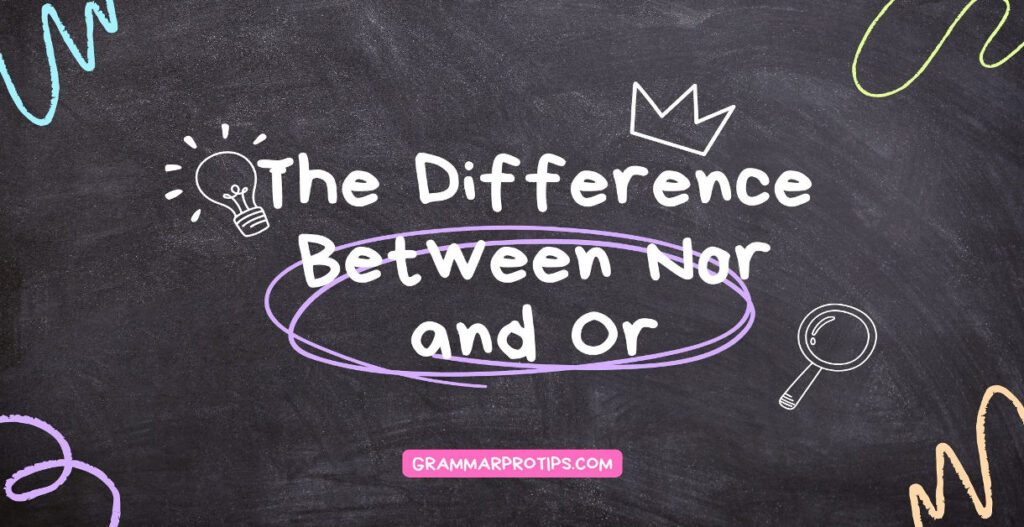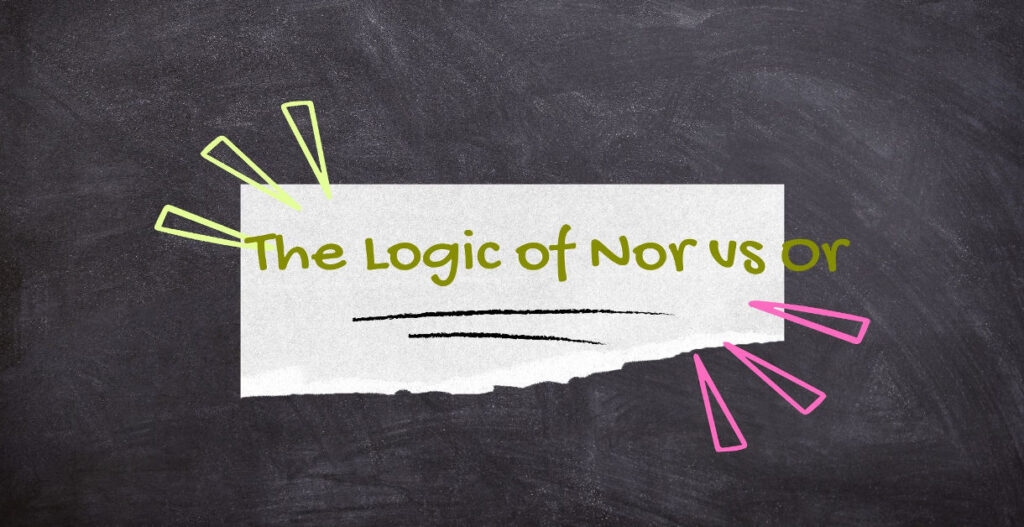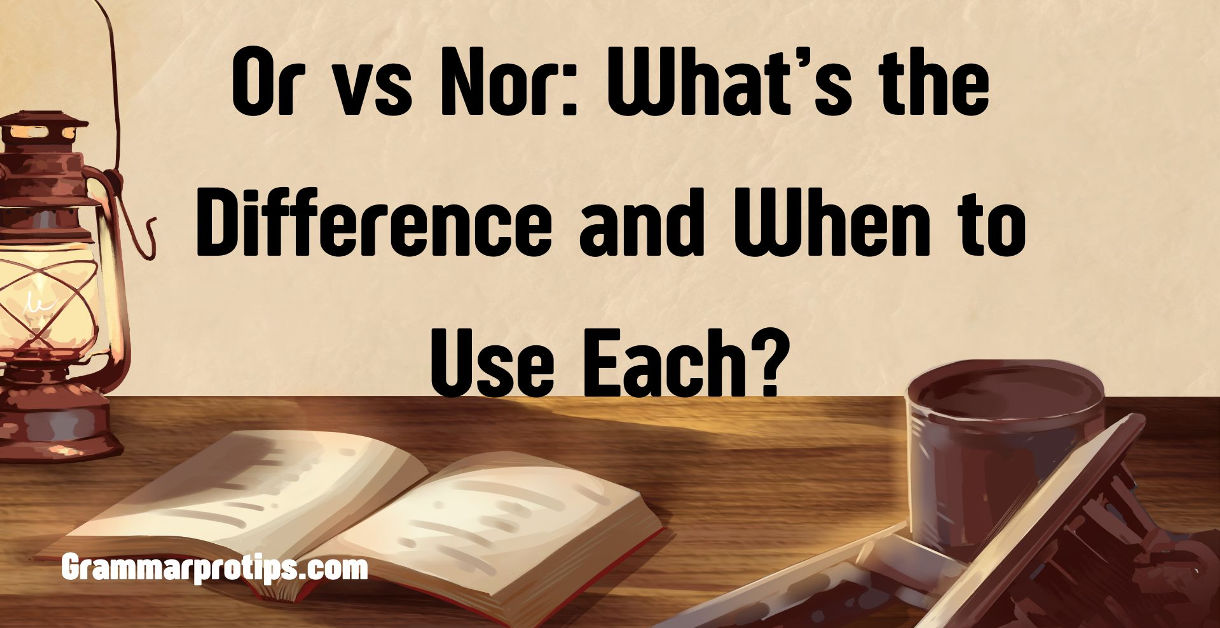Conjunctions are essential elements of English grammar. They help to connect words, phrases, and clauses in a sentence, making communication more cohesive. While most people are familiar with common conjunctions like “and” and “but”, “or” and “nor” can often cause confusion.
In this article, we will dive into the difference between or and nor, explore or vs nor examples, and examine when to use nor without neither. We will also look at the broader implications of or vs nor logic, the importance of grammar rules, and when each conjunction is appropriate in both informal and formal language.
What Is a Conjunction?
Before we dive into the nuances of “or” vs “nor“, it’s important to understand what a conjunction is. A conjunction is a word used to connect other words, phrases, or clauses within a sentence. Common conjunctions include words like “and”, “but”, “yet”, and “because”.
There are two main types of conjunctions:
- Coordinating conjunctions (e.g., “and,” “but,” “or,” “nor”)
- Subordinating conjunctions (e.g., “although,” “because,” “if”)
In this article, we’ll focus on coordinating conjunctions, specifically “or” and “nor”.
Or vs Nor: A Quick Overview
While both “or” and “nor” are used to connect ideas, their functions are different. Understanding these differences is crucial in using them correctly. Here’s a quick breakdown:
- “Or” is typically used to present choices or alternatives. It’s used when offering a selection between two or more options.
- Example: Do you want coffee or tea?
- “Nor”, on the other hand, is generally used to present a negative alternative. It often follows a negative clause and negates both options presented.
- Example: She doesn’t like coffee, nor does she like tea.
The Difference Between Nor and Or: Usage in Negative Sentences

One of the most important distinctions between “nor” and “or” is their use in negative constructions. While “or” is used to present choices or alternatives, “nor” is often used in negative sentences, typically after a word like “neither” or “not”.
When to Use Nor Examples
- “Nor” is commonly used after “neither” to connect two negative alternatives:
- Example: I have neither the time nor the patience for this.
- “Nor” can also be used after a negative clause when negating multiple elements:
- Example: She doesn’t play basketball, nor does she play tennis.
When Not to Use Nor
It’s essential to know when not to use “nor”. In positive statements or when offering choices between alternatives, “or” should be your go-to conjunction.
- Incorrect: She likes coffee, nor does she enjoy tea.
- Correct: She likes coffee, or she enjoys tea.
- Incorrect: I will take the red shirt, nor the blue one.
- Correct: I will take the red shirt, or the blue one.
Inversion in Negative Sentences
One key feature of “nor” is that it often leads to inversion in negative sentences. In standard English word order, the subject generally comes before the verb. However, after “nor”, the verb often precedes the subject, which is known as inversion.
- Example with inversion: He doesn’t like to sing, nor does he enjoy dancing.
- Example without inversion: He doesn’t like to sing, and he doesn’t enjoy dancing.
Or vs Nor Examples in Different Contexts
Let’s look at some examples in various contexts to clarify the difference between or and nor. This will help you understand how to use these conjunctions correctly in both casual and formal settings.
1. Informal Email: Choosing Between Or and Nor
Imagine you’re writing an email to a friend about plans for the weekend:
Subject: Weekend Plans
Hi Alex,
I could either go to the park or we could just hang out at my place. I don’t have a preference. Let me know what sounds better to you!
Best,
Tom
In this example, “or” is used because the writer is offering choices or alternatives.
2. Formal Email: Negative Alternatives with Nor
Now, let’s look at a more formal email example where “nor” is used to present negative alternatives:
Subject: Project Update
Dear Mrs. Carter,
I regret to inform you that I have not yet completed the report, nor have I received the necessary data from the team. I will continue working on it and will send you an updated version as soon as possible.
Best regards,
James
In this case, “nor” connects two negative clauses after the first one (“I have not yet completed”). The use of “nor” emphasizes the negation and continues the negative structure in the sentence.
The Logic of Nor vs Or

When looking at nor vs or logic, it’s helpful to consider the types of choices being presented.
- “Or” is about presenting alternatives where at least one option is possible.
- “Nor” is typically used to continue a negative sequence. When you use nor, you’re usually saying that neither option is true, or neither alternative exists.
Using Nor Without Neither: An Exception
You may have heard that “nor” typically follows “neither”, but that’s not always the case. You can also use nor to continue a negative construction without neither. This is common when negating an action or state.
- Example: He doesn’t like apples, nor does he eat bananas.
- Example: I don’t want to go to the movies, nor do I feel like staying at home.
Notice how “nor” follows the negative clause (not wanting to go to the movies or stay home) and connects the two related ideas.
Common Mistakes with Conjunctions
A common mistake is using “nor” in positive contexts. Here’s a look at what not to do:
- Incorrect: I want pizza, nor do I want pasta.
- Correct: I want pizza, or I want pasta.
- In this case, the sentence is presenting a choice between two alternatives, so “or” is the correct conjunction.
Another frequent error is incorrect inversion. Remember, inversion occurs after “nor”, but it’s unnecessary after “or” in negative contexts.
- Incorrect: I don’t like ice cream, nor I like cake.
- Correct: I don’t like ice cream, nor do I like cake.
Table: Or vs Nor
Here’s a quick reference table comparing “or” and “nor” in different scenarios:
| Scenario | Or | Nor |
|---|---|---|
| Presenting a choice | Do you want coffee or tea? | Not applicable |
| Negative alternative | Not applicable | She doesn’t like coffee, nor does she like tea. |
| After “neither” | Not applicable | I have neither the time nor the patience. |
| After “not” | Not applicable | He doesn’t want to play, nor does he want to watch. |
| Inversion | Not applicable | He doesn’t play tennis, nor does he play basketball. |
Conclusion: Correct Use of Or and Nor
Understanding the difference between or and nor is essential for mastering grammar in writing, especially when it comes to negative sentences and alternatives. “Or” is your go-to conjunction for presenting choices, while “nor” is used to negate both alternatives and often triggers inversion in negative sentences.
When writing, always consider the sentence structure and the logic behind your conjunction choice. By following the rules and using nor vs or correctly, you can enhance the clarity of your writing and avoid common mistakes. Keep practicing, and soon using “nor” and “or” will feel second nature!
Feel free to use these tips next time you’re deciding between “or vs nor” in your own writing, whether it’s an email, academic paper, or casual text.

“Smith is the dedicated admin of [grammarprotips.com], a platform focused on enhancing grammar skills. With a passion for language and education, Smith strives to make grammar accessible and enjoyable for learners of all levels. Committed to delivering high-quality content, Smith continually explores innovative ways to help users master the complexities of grammar.”

